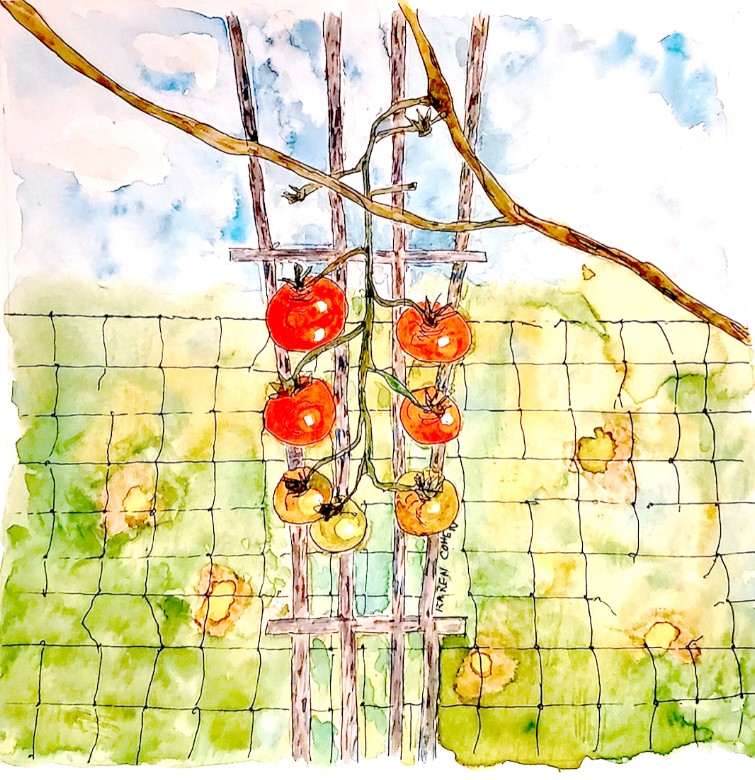Seeing Red
By Karen Cohen

I’m back! What seems like a billion years ago, we packed our vehicle and moved south. To say it was hot was an understatement. Jumping into a swimming pool with water temps at 92 degrees, perfect bath water temps, was always followed by a cold shower. After more traveling, we landed back to this place some call “almost heaven,” where the livin’ is easy and much, so much cooler!
In the late ‘90s the Mountain Messenger featured my gardening column called Nature’s Way. It was not online and only available in newspaper print. I am happy to revive it to share tips/ideas on gardening with you again. Born in the “garden state of New Jersey,” I know about Jersey tomatoes, renown throughout the states. Seems like everybody grew these in their backyard gardens along with marigolds, zinnias, and zucchinis. I learned from my mom who had a green thumb and then studied more with the Master Gardener Cooperative.
Our Greenbrier County garden is well underway. This transplant has transplanted ten tomato plants, all heirlooms: Brandywine, Cherokee Purple and Black Crim. Roma, a plum tomato, is great for dehydrating and using all winter long in sauces and salads. Sweet 100’s and Sungolds are a yearly must-have producing buckets of small cherry tomatoes that taste like candy right off the vine. Let me know some of your favs. I learned about Mortgage Lifter right here in West Virginia. Research claims that the original farmer who grew these tomatoes back in the 1930’s sold so manythat he was able to pay off the mortgage on his family farm in Kentucky. These are big, juicy maters.
Growing terms to familiarize yourself with:
Indeterminate tomatoes: This plant will produce throughout a growing season with a few rounds of fruit, not just one time.
Determinate tomatoes produce all at once and then are kaput.
Open pollinated plants. That means the birds, the bees, and the breeze can pollinate the flowers which will bear fruit identical to its parent plant and has viable seeds that can be dried, saved, and replanted the next year.
Hybridized plants and seeds grow in scientifically controlled growing fields to produce a crop, but the fruit will be sterile. The seeds from a hybrid plant are not guaranteed to produce a reliable second generation. Science has improved many plants and seeds, enabling resistance to common garden diseases and drought; there are pros and cons to hybrids. You have a choice.
Which do I prefer? All of the above.
Note to reader: tomatoes are fruit though many consider them a vegetable.
Another red fruit that’s popular is strawberries. Eating one fresh off the vine is like a little bit of heaven. Recently I visited the Sunset Berry Farm in Alderson. More than ten years ago, owners and farmers Kent and Jennifer started growing strawberries, sweet corn, beans, sunflowers, and watermelon. Last weekend they hosted a scrumptious strawberry-centric, farm to table dinner. We had a strawberry vinaigrette with crunchy lettuce greens mixed with slices of sweet strawberries and finished with strawberry shortcake and chocolate dipped strawberries. After dinner, a taste comparison group tour was led into the fields to sample four varieties of strawberries: Chandler, Ruby June, Malwina, and #1 favorite Flavorfest. These hard-working farmers invite you to PYO = pick your own strawberries now until mid-June. Strawberries freeze nicely to use later in yogurts, breakfast cereals, shortcakes and topping over ice cream. Send in your recipes! Sunflowers and watermelon will be coming next, plan a trip with friends to get some of the sweetest fruit you can imagine. Do stick around to see the sunset, gorgeous over Keeney’s knob in the distance.
For hours, information, and events, go to https://sunsetberryfarm.net/.


